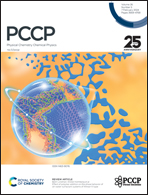Boron-doped graphene topological defects: unveiling high sensitivity to NO molecule for gas sensing applications†
Abstract
Global air quality has deteriorated significantly in recent years due to large emissions from the transformation industry and combustion vehicles. This issue requires the development of portable, highly sensitive, and selective gas sensors. Nanostructured materials, including defective graphene, have emerged as promising candidates for such applications. In this work, we investigated the B-doped topological line defect in graphene as a sensing material for various gas molecules (CO, CO2, NO, and NH3) based on a combination of density functional theory and the non-equilibrium Green's function method. The electronic transport calculations reveal that the electric current can be confined to the line defect region by gate voltage control, revealing highly reactive sites. The B-doped topological line defect is metallic, favoring the adsorption of NO and NH3 over CO and CO2 molecules. We notice changes in the conductance after gas molecule adsorption, producing a sensitivity of 50% (16%) for NO (NH3). In addition, the recovery time for nitride gases was calculated for different temperatures and radiation frequencies. At 300 K the ultraviolet (UV) has a fast recovery time compared to the visible (VIS) one by about two orders of magnitude. This study gives an understanding of how engineering transport properties at the microscopic level (by topological line defect and chemical B-doping) leads to promising nanosensors for detecting nitride gas.



 Please wait while we load your content...
Please wait while we load your content...